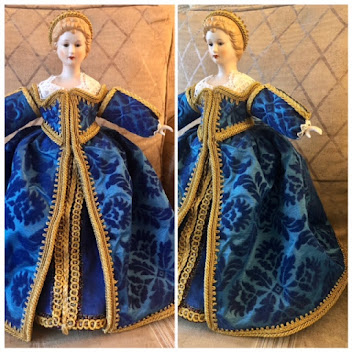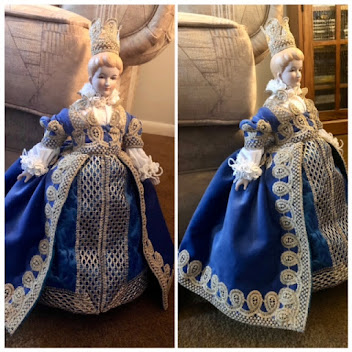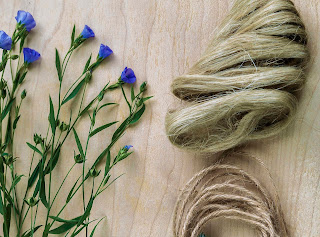Sunday, August 18, 2019
Born to be Wild
Recently I was researching the internet for books about wild plants that produce fibers for textile production. Which is trickier search than it seems, I was finding many books on edible wild plants. Interesting side note in my searching: numerous books on plant based dying, how to do it and grow those plants in ones garden. Although not the end result, that I was searching for initially. I had found a few books on nature survival; of which I have two good ones at home. Will have to see if they have some use for this topic. Which also seems to be a topic called Bush-craft besides wilderness survival. My past times working in library circulation do come in handy. Even before my involvement in the SCA, I had an interest in foraging for useful plants in nature. Which was further fueled by my choice in studying ornamental horticulture in college for my degree. Which recently came in handy identifying pesky weeds at my parents house and how to kill them effectively.
In this case, I am looking into plants that could be used to make a mild cordage that could be combed to become more textile like soft fibers. The cellulose is produced in one of three ways in the plant: the seed pods filaments, bast fibers from the stem, or leaf fibers. Most of the processes to get the fibers extracted involve a drying technique and extensive combing of the collected fibers. There are a few variables I didn't account for from prior, mainly when to harvest. Sometimes if one gathers too early even in the drying process the fibers may not be present yet or in not enough abundance to bother all the production to get the fibers out of the plant. So I will specifically research more on timing for this, has to be a manual somewhere. Also will look into native american tradition on this as well.
Specifically on Teasel to see about how others have used this plant, besides the carding qualities of the dried seed heads. Recently the first year plant of Teasel, specifically the root was found to be useful to treat medication resistant forms Lyme's Disease. All sorts of useful information but not on fibers, hmm. Its a thick tall thick stalked plant, has to have some further use. In my searching I found an few other wild plants that are native to the Northeastern United States. Many of these plants also could be found in many parts of the temperate US and in temperate Europe and are mostly unwanted plants. Many of these individual plants are in related families of plants.
One of the more common is Milkweed. Its bast fibers are usable from the stem after a completely dried plant. I found that Dogbane also known as Indian Hemp, is related to Milkweed and is poisonous to animals. Which makes the storage of the plant for this much trickier in a pet friendly home. I want to find out if the dried plant is chewed on does it still make an animal sick, if so it won't be viable option for me. Jace chews everything, even though he is a year old now. He laid waste to a whole spool of white silk thread I discovered his work yesterday. He didn't eat as much play, make dirty, tangled, pretty much a waste.
The other is bramble, which is in the family of thistles. The stem and thick roots again can be used to make rope. Stinging Nettle is known to make some very nice linen like fiber after being well combed. I know has been looked into as a sustainable renewable fiber more on the textile end. In the far east, bamboo is also another sustainable fiber that is has so many uses also more on the textile end. There are varieties of hemp in modern times with the regulations on this and growing even as garden plan, certain this is not a viable option just yet.
As far as cordage for making rope; cedar bark, willow bark which is stripped from green stems not from dried stems. In this application you are working with the wet fibers to flex them into the twist for keeping their shape. So lots of information but wish there was a good book for all this. There maybe a spot in the market to make another one. Who knows if you find a space lacking in research write the book.
Be Curious and Discover,
THL Marrin O'Kealy
Subscribe to:
Post Comments (Atom)
Replica 1560's Venetian Italian Fashion Doll

Replica 1560 French Fashion Doll

Tudor Q and A
What is a Tudorosity?
A mashed combination of the words Tudor and Curiosity to create the word Tudorosity. Tudorosities is the plural form and the deffinition is as follows.
Tudorosity- an desire to learn or know anything about the Tudor dynasty associated with years 1405 through 1603.
Most people ask my why I make the Tudor garb ?
I find the clothing of this era not only beautiful but also challenging to sew. There is much more care and purpose put into making garments and wearing garments in the Tudor Era. I love the look of Tudor so much I wanted to explore the way clothes were made back then and the subtle changes in fashion and styles of time.
How did you get started in this interesting hobby?
I started with art first, I love to draw, paint, and sculpt all the traditional fine arts. So being able to draw helps me visualize the looks I want to create in my garb. History has always been a huge interest of mine and I've had a knack for sewing since I was 7 years old. It all started with doll clothes and I learned cross stitch embroidery from my grandmother when I was little. I am self taught sewer, crochet, knitting, embroidery and tatting. My methods are learned from books mainly and there is still so much more to learn.
What is my favorite outfit and why?
It would be like picking a favorite out of one of my future children, its impossible. I love all my gown creations and really like the distinct differences in all the styles clothing I make for the Tudor Era.
Do you make the whole outfit including hat, shoes, and undergarments?
I do have a goal of making a complete Tudor from the skin out. As of right now I make 90% of my gowns and accessories. The shoes and stockings, are bought online and the petticoats are a close reproduction but not made by me. .
How long does it take to make a gown?
It all depends on the type of gown. The making relies on the time period and class of the design. Generally if I work on it 8 hours a day on a sewing machine it will take 3 days to get the basics and another 5 days to do finish hand-sewing details and beading. So a week to a week and a half if working on it steady for that amount of time. I work a full-time job so it does take longer than a week to complete. I put over 40-100 hours per outfit depending on its complexity, its like its own full time job of sorts.
Do you make renaissance clothing for sale or custom orders?
No, due to new employment and changes in my lifestyle. Unfortunately, I have no time to support sewing for others. Though I recommend sewing lessons for those adventurous few. There are many fine folks who make and sell historical clothing. I suggest guidance with sew from many fine historical enthusiastic costumers out on the internet.
How long have you been making these elaborate costumes?
I have been in the Society of Creative Anachronism coming up on my 18th year. Active since 2004 working at demonstrations and volunteering when I could between working and other life's distractions. I really concentrated on Tudor sewing in 2007 and worked with patterns to learn proper fabrics, techniques, fit, and silhouette. I really enjoy the eras transition from a medieval form fitting layered cotterdie to the boned Tudor kirtle and then to structured Elizabethan clothing.
A mashed combination of the words Tudor and Curiosity to create the word Tudorosity. Tudorosities is the plural form and the deffinition is as follows.
Tudorosity- an desire to learn or know anything about the Tudor dynasty associated with years 1405 through 1603.
Most people ask my why I make the Tudor garb ?
I find the clothing of this era not only beautiful but also challenging to sew. There is much more care and purpose put into making garments and wearing garments in the Tudor Era. I love the look of Tudor so much I wanted to explore the way clothes were made back then and the subtle changes in fashion and styles of time.
How did you get started in this interesting hobby?
I started with art first, I love to draw, paint, and sculpt all the traditional fine arts. So being able to draw helps me visualize the looks I want to create in my garb. History has always been a huge interest of mine and I've had a knack for sewing since I was 7 years old. It all started with doll clothes and I learned cross stitch embroidery from my grandmother when I was little. I am self taught sewer, crochet, knitting, embroidery and tatting. My methods are learned from books mainly and there is still so much more to learn.
What is my favorite outfit and why?
It would be like picking a favorite out of one of my future children, its impossible. I love all my gown creations and really like the distinct differences in all the styles clothing I make for the Tudor Era.
Do you make the whole outfit including hat, shoes, and undergarments?
I do have a goal of making a complete Tudor from the skin out. As of right now I make 90% of my gowns and accessories. The shoes and stockings, are bought online and the petticoats are a close reproduction but not made by me. .
How long does it take to make a gown?
It all depends on the type of gown. The making relies on the time period and class of the design. Generally if I work on it 8 hours a day on a sewing machine it will take 3 days to get the basics and another 5 days to do finish hand-sewing details and beading. So a week to a week and a half if working on it steady for that amount of time. I work a full-time job so it does take longer than a week to complete. I put over 40-100 hours per outfit depending on its complexity, its like its own full time job of sorts.
Do you make renaissance clothing for sale or custom orders?
No, due to new employment and changes in my lifestyle. Unfortunately, I have no time to support sewing for others. Though I recommend sewing lessons for those adventurous few. There are many fine folks who make and sell historical clothing. I suggest guidance with sew from many fine historical enthusiastic costumers out on the internet.
How long have you been making these elaborate costumes?
I have been in the Society of Creative Anachronism coming up on my 18th year. Active since 2004 working at demonstrations and volunteering when I could between working and other life's distractions. I really concentrated on Tudor sewing in 2007 and worked with patterns to learn proper fabrics, techniques, fit, and silhouette. I really enjoy the eras transition from a medieval form fitting layered cotterdie to the boned Tudor kirtle and then to structured Elizabethan clothing.
Replica 1490 Milan Italian Fashion Doll

Based on art by Giovanni Ambrogio
O’Kealy Heraldry





No comments:
Post a Comment